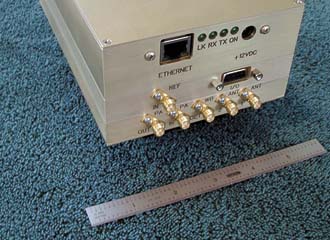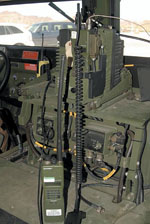Dynamic Spectrum Access Bursts Into Airwaves
 |
The Worldwide Interoperability for Microwave Access-based radio served as the primary Dynamic Spectrum Access (DSA) prototype used for developing and testing DSA technologies in the Defense Advanced Research Projects Agency’s (DARPA’s) Next Generation (XG) Program. It was developed by the Shared Spectrum Company and was generically referred to as the XG Prototype Radio. |
Radio technology being developed by the Defense Advanced Research Projects Agency uses electromagnetic spectrum so effectively that it has gained White House attention and is being touted by government officials for possible commercial use both domestically and internationally.
In recent years, the demand for spectrum has swelled immensely, both commercially and within the military. Cellular telephones, wireless e-mail, digital audio and high-definition television all compete for the same spectrum the military needs for command, control, communications, computers, intelligence, reconnaissance and surveillance technologies. With so many demands on the spectrum,
The dynamic spectrum access (DSA) radio technology developed under the Defense Advanced Research Projects Agency’s (DARPA’s) Next Generation (XG) program has undergone recent successful demonstrations and is being adopted by other military programs and studied by other government agencies. Commercial use both domestically and internationally also is a possibility. The U.S. Federal Communications Commission (FCC), which regulates commercial spectrum use, is touting the technology to the International Telecommunication Union, the U.N. agency that coordinates international information and communications technologies issues, as a possible solution to more effectively use spectrum around the world.
With the potential for commercial and international use of its DSA technology comes a busy schedule for the XG program office.
“We had an international conference in Singapore in the spring that was based on XG; I’m meeting with the National Science Foundation; we have another international meeting; and the Federal Communications Commission has been putting forth efforts to see if dynamic spectrum access can be used worldwide,” says Larry Stotts, XG program manager and deputy director of DARPA’s Strategic Technology Office.
The XG program already was garnering a lot of attention but received a major public awareness boost this summer, thanks to White House efforts to increase spectrum availability. Freeing up more spectrum will better accommodate the technology explosion, according to government officials. The White House in June released a presidential memorandum signed by President Barack Obama that outlines a four-part strategy to free up 500 megahertz of spectrum by the end of the decade. The president calls for the administration to identify and plan for the release of spectrum; provide new tools and incentives to free up spectrum; redeploy spectrum to high-value uses, such as mobile broadband, which is growing exponentially with the use of smart phones, netbooks and wireless devices; and to auction off spectrum to provide funds for public safety and infrastructure investments.
On the same day the president’s plan was announced, Lawrence Summers, director of the White House National Economic Council, described the shortage of available spectrum as a “spectrum crunch.” He estimates that in recent years, the amount of information flowing over some wireless networks has grown at a rate of “more than 250 percent per year” and states that, “By some estimates, the next five years will see an increase in wireless data of 20 to 45 times 2009 levels.”
Along with the four-part plan, the administration released a fact sheet that specifically mentions DARPA’s XG program and the National Science Foundation’s Enhancing Access to Radio Spectrum program, which supports research enabling more people to share spectrum. “Certain smart radio technologies are already being used by the Pentagon. Several initiatives, such as DARPA’s XG program and the National Science Foundation’s Enhancing Access to Radio Spectrum initiative, are working on advanced sharing technologies for both national security and commercial applications.” The administration will invest in better ways to share spectrum, according to the document.
Despite the burgeoning demands on available spectrum, however, only about five percent is used at any given time on average. As a result, DSA technology could take advantage of up to 95 percent of unused spectrum, depending on the circumstances. Stotts concedes that in densely populated urban areas, where spectrum can be as congested as the roadways, the DSA likely would do little good simply because there is not enough free spectrum available. Still, the DSA will be a “big step forward” anywhere underutilized spectrum exists, he says.
The DSA software monitors the spectrum for unused frequencies, which the DSA-enabled radio will automatically jump to even if that portion of the spectrum is not owned by the Defense Department. If the spectrum owner powers up a communications device, the DSA senses that device coming online and automatically jumps to another band of unused spectrum without disrupting the DSA user’s communications or interfering with others’ communications efforts.
 |
DARPA’s DSA software has been demonstrated on several radios, including the Harris AN/PRC-152 handheld, one of which is shown here in the VRC-110 vehicle-mounted configuration using a vehicle adapter, which allows higher power output and longer ranges through a vehicle-mounted antenna. |
And increasing data rate is a primary goal for sharing spectrum. Stotts compares the spectrum crunch to having too many users on the Internet at the same time. The connection slows, and some users can be booted off, losing data, which can be deadly during combat. But when fewer users are connected—at 3 a.m., for example—or when more spectrum is available, connections are much faster.
Stotts adds that the Joint Tactical Radio System program office also is interested in the DSA technology, which already has been demonstrated on the Enhanced Position Location Reporting System and on AN/PRC-148 and AN/PRC-152 handheld, push-to-talk radios. DARPA’s Mobile Ad hoc Interoperability Network Gateway program and its Wireless Network after Next program also are making use of the DSA technology.
DARPA’s DSA technology is capable of operating in the same bands as existing communications networks. It can abandon channels within a half second of sensing another user and can operate in the presence of other DSA users, non-users and malicious jammers. Stotts and his team recently demonstrated its function successfully using a 50-node network and are scheduled to demonstrate a 100-node capability this fall for the U.S. Army. If that demonstration is successful, the Army Program Executive Office, Command, Control and Communications–Tactical, may decide to adopt the capability, Stotts explains.
In recent years, DARPA has held several major field evaluations for its DSA technology. Some of those demonstrations were witnessed by hundreds of representatives from the Defense Department, other government agencies and private entities. The initial test in 2006 demonstrated for the first time a network of DSA radios capable of using spectrum over a wide range of frequencies on a secondary basis, according to a Commerce Department report released in May. It also demonstrated the ability of DSA networks to support a variety of traffic loads ranging from low-bit-rate data up to streaming video.
DARPA also has shown that DSA-enabled radios can be programmed with policy modules so that no matter where in the world the radio is located, they can automatically adhere to spectrum usage policies. The radios successfully conformed to policies that restricted communications within particular geographic areas designated by their Global Positioning System coordinates and determined which channels were available in which areas.
DARPA’s DSA technology is not the only solution for sharing spectrum. A number of companies have begun research on DSA capabilities in recent years, but DARPA’s technology is “state-of-the-art,” according to a Commerce Department report released in May. Stotts points out that some in the commercial sector prefer a “cooperative” solution, whereas different organizations would own pieces of the spectrum at different dates and times. Because of jamming and other potential interference with military or national emergency operations, however, that suggestion does not sit well with the military or other government agencies. One potential solution, Stotts explains, is for the military to pay the owners of a given spectrum band anytime that band is used. “If I grab your spectrum, you get paid while I’m using it. And if I go to someone else’s spectrum, they get some money,” Stotts says.
The White House fact sheet that accompanied release of the president’s plan supports spectrum sharing. “New technologies have made it possible to use government spectrum more efficiently while protecting critical activities such as national defense, homeland security and air traffic control. Where appropriate, a sharing arrangement, for example, can authorize a commercial provider to use a band of spectrum at most times, but stipulate that government communications or other critical activities will take over when they need access to the band,” the document states.
Stotts is sharing results of the XG program with representatives from virtually every government agency that uses spectrum, including the FCC, Energy Department, National Science Foundation, Defense Information Systems Agency, National Institute of Standards and Technology, the Federal Aviation Administration, Federal Emergency Management Agency, National Security Agency, Central Intelligence Agency, Federal Bureau of Investigation and the Department of Homeland Security, all of which participate in a DSA Coordination Group led by the Commerce Department’s National Telecommunications and Information Administration.
The DSA Coordination Group put out a draft report in August outlining DSA enabling technologies, challenges and accomplishments. Enabling technologies include software-defined radios; cognitive radios that are aware of the electromagnetic environment and capable of making spectrum use decisions based on that environment; cognitive antennas, which extend the cognitive radio capability; and frequency agility, which is the ability to change operating frequency automatically. Some technologies are more mature than others, but all are being developed by the Defense Department.
DARPA also is coordinating with the U.S. Army’s Training and Doctrine Command to provide technologies that would make cellular telephones more useful for soldiers on the ground without clogging commercial cellular telephone spectrum. “We’re looking at techniques to provide more capabilities to cellular devices so maybe the military can use those systems without dragging down the commercial guys—because commercial users don’t appreciate it when we try to take over their networks,” Stotts notes.
WEB RESOURCES
XG website: www.darpa.mil/sto/programs/xg/
President Obama’s Spectrum Management Plan: http://bit.ly/bWVTa9
White House Fact Sheet on Spectrum: http://bit.ly/9jSkQR




Comments